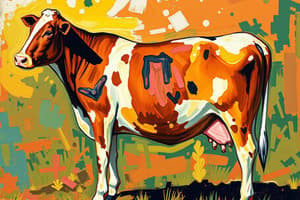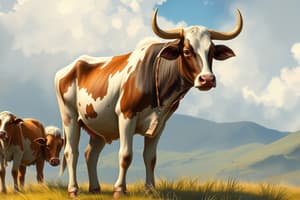Podcast
Questions and Answers
Sickle-hocked is a term used to describe steers which are too straight on their hind legs.
Sickle-hocked is a term used to describe steers which are too straight on their hind legs.
True (A)
Which of the following is NOT a goal of the beef producer concerning customer preference?
Which of the following is NOT a goal of the beef producer concerning customer preference?
- Fatty carcass (correct)
- Tender meat
- Juicy meat
- Flavorful meat
The acceptable weight range of an ideal market steer should be ____________.
The acceptable weight range of an ideal market steer should be ____________.
1150-1250
Structural Correctness and Balance are related to ____________.
Structural Correctness and Balance are related to ____________.
Which major factors should be considered when evaluating market steers?
Which major factors should be considered when evaluating market steers?
One of the best indicators of muscling in a steer may be observed in the ___________.
One of the best indicators of muscling in a steer may be observed in the ___________.
Body builders have defined muscles; the same should be true for steers.
Body builders have defined muscles; the same should be true for steers.
Market steers with coarse, heavy front ends will have a lower ratio of the higher valued boneless, closely trimmed retail cuts.
Market steers with coarse, heavy front ends will have a lower ratio of the higher valued boneless, closely trimmed retail cuts.
Which of the following is the order of the deposition of finish?
Which of the following is the order of the deposition of finish?
In determining the ideal carcass weight, what factor should one consider in evaluating the live animal?
In determining the ideal carcass weight, what factor should one consider in evaluating the live animal?
Animals which appear sharp in their shoulders may not have enough muscle and finish to indicate market-readiness.
Animals which appear sharp in their shoulders may not have enough muscle and finish to indicate market-readiness.
In producing superior beef, the optimum goal is selecting a steer with the largest ribeye possible.
In producing superior beef, the optimum goal is selecting a steer with the largest ribeye possible.
Balance is a term used by livestock evaluators to indicate the smoothness and evenness of finish.
Balance is a term used by livestock evaluators to indicate the smoothness and evenness of finish.
The widest portion of an ideal steer, when viewed from behind, should be what portion of the round?
The widest portion of an ideal steer, when viewed from behind, should be what portion of the round?
What is the appropriate placing of the Shorthorn market steer class?
What is the appropriate placing of the Shorthorn market steer class?
In order to reach the USDA Choice quality grade, the fat opposite the 12th rib should measure which of the following?
In order to reach the USDA Choice quality grade, the fat opposite the 12th rib should measure which of the following?
An acceptable window for an optimum retail cut is called _______________.
An acceptable window for an optimum retail cut is called _______________.
The goal of a (market steer) livestock evaluator should be to select the highest degree of finish, to ensure the Choice quality grade.
The goal of a (market steer) livestock evaluator should be to select the highest degree of finish, to ensure the Choice quality grade.
Straight shoulder is just one characteristic which may affect a market steer's performance in a feedlot.
Straight shoulder is just one characteristic which may affect a market steer's performance in a feedlot.
A correctly finished steer provides retail product without excessive trim.
A correctly finished steer provides retail product without excessive trim.
Study Notes
Livestock Judging: Market Steers
- Sickle-hocked steers lack proper hind leg structure, appearing overly straight.
- A fatty carcass does not align with beef producer goals regarding customer preferences.
- Ideal market steer weight ranges from 1150 to 1250 pounds.
- Structural correctness and balance are essential for evaluating performance, muscling, and finish.
- Key assessment factors for market steers include balance in body structure.
- Muscling indicators in steers are prominently observed in the stifle area.
- Just as bodybuilders exhibit defined muscles, so too should market steers have visible musculature.
- Coarse, heavy front ends of market steers result in lower-value retail cuts.
- The deposition of finish in steers follows the order: neck, behind the shoulder, flank.
- Evaluating live animals for ideal carcass weight requires analysis of muscling, finish, and fill.
- Sharp shoulder appearance in animals may signal inadequate muscle and finish for market readiness.
- The largest ribeye is not necessarily the optimal goal when producing superior beef.
- Balance refers to body symmetry and proportion, not simply smoothness of finish.
- When viewed from behind, an ideal steer should be widest at the middle of the round.
- The Shorthorn market steer class placing is typically 1-3-4-2.
- To reach the USDA Choice quality grade, fat measurement opposite the 12th rib should be between .30 to .50 inches.
- Portion control defines the acceptable range for optimum retail cuts.
- Evaluators should not prioritize the highest degree of finish alone when selecting market steers.
- A straight shoulder can hinder a market steer's feedlot performance.
- Correctly finished steers yield retail products with minimal excessive trimming.
Studying That Suits You
Use AI to generate personalized quizzes and flashcards to suit your learning preferences.
Description
Test your knowledge on livestock judging, specifically market steers, with these flashcards. Learn about terms, goals of beef producers, and ideal weight ranges for market steers. Perfect for students and enthusiasts in the field of livestock evaluation.




